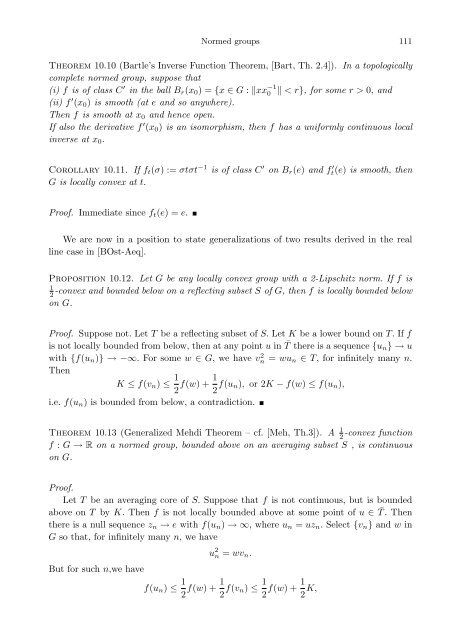Normed versus topological groups: Dichotomy and duality
Normed versus topological groups: Dichotomy and duality
Normed versus topological groups: Dichotomy and duality
You also want an ePaper? Increase the reach of your titles
YUMPU automatically turns print PDFs into web optimized ePapers that Google loves.
<strong>Normed</strong> <strong>groups</strong> 111Theorem 10.10 (Bartle’s Inverse Function Theorem, [Bart, Th. 2.4]). In a <strong>topological</strong>lycomplete normed group, suppose that(i) f is of class C ′ in the ball B r (x 0 ) = {x ∈ G : ‖xx −10 ‖ < r}, for some r > 0, <strong>and</strong>(ii) f ′ (x 0 ) is smooth (at e <strong>and</strong> so anywhere).Then f is smooth at x 0 <strong>and</strong> hence open.If also the derivative f ′ (x 0 ) is an isomorphism, then f has a uniformly continuous localinverse at x 0 .Corollary 10.11. If f t (σ) := σtσt −1 is of class C ′ on B r (e) <strong>and</strong> f ′ t(e) is smooth, thenG is locally convex at t.Proof. Immediate since f t (e) = e.We are now in a position to state generalizations of two results derived in the realline case in [BOst-Aeq].Proposition 10.12. Let G be any locally convex group with a 2-Lipschitz norm. If f is12-convex <strong>and</strong> bounded below on a reflecting subset S of G, then f is locally bounded belowon G.Proof. Suppose not. Let T be a reflecting subset of S. Let K be a lower bound on T. If fis not locally bounded from below, then at any point u in ¯T there is a sequence {u n } → uwith {f(u n )} → −∞. For some w ∈ G, we have v 2 n = wu n ∈ T, for infinitely many n.ThenK ≤ f(v n ) ≤ 1 2 f(w) + 1 2 f(u n), or 2K − f(w) ≤ f(u n ),i.e. f(u n ) is bounded from below, a contradiction.Theorem 10.13 (Generalized Mehdi Theorem – cf. [Meh, Th.3]). A 1 2-convex functionf : G → R on a normed group, bounded above on an averaging subset S , is continuouson G.Proof.Let T be an averaging core of S. Suppose that f is not continuous, but is boundedabove on T by K. Then f is not locally bounded above at some point of u ∈ ¯T . Thenthere is a null sequence z n → e with f(u n ) → ∞, where u n = uz n . Select {v n } <strong>and</strong> w inG so that, for infinitely many n, we haveBut for such n,we haveu 2 n = wv n .f(u n ) ≤ 1 2 f(w) + 1 2 f(v n) ≤ 1 2 f(w) + 1 2 K,
















